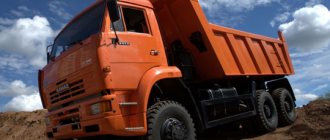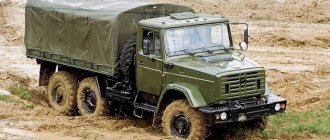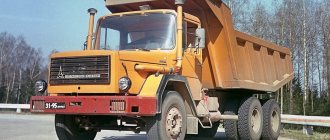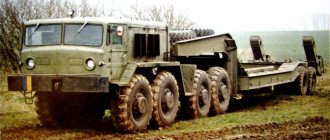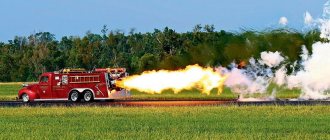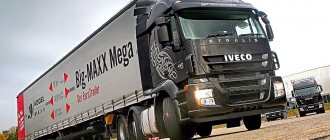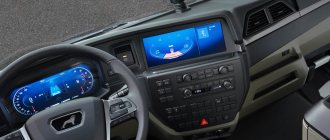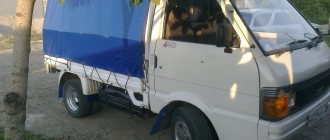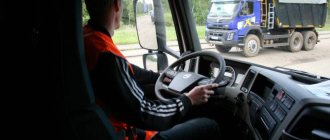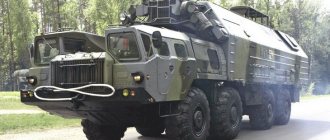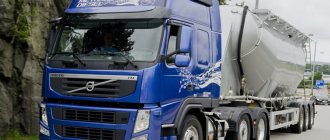KamAZ in the service of the Russian Army.
The importance of military trucks as a means of ensuring the mobility of security forces is increasing from year to year. Today, this type of transport differs from conventional trucks in the multi-purpose nature of its use, and Russian military trucks also have increased reliability and ease of operation, which has been proven more than once in military operations with their participation. Modern trucks are adapted for transporting materiel and soldiers, towing artillery systems, installing weapons and directly participating in combat operations.
War is not won only on the battlefield, and modern means of cargo transportation, thanks to the good supply of the army and the rapid movement of material resources, make it possible to win battles even before they begin. The issues of the vehicle fleet in the Russian Armed Forces are directly dealt with by the Main Armored Directorate. The department, in turn, works closely with domestic automobile manufacturers and design bureaus.
Production of the first trucks in the USSR
The first trucks for the needs of the army were created on the basis of existing foreign models from the Dodge and Ford concerns. These cars were significantly modified by the Gorky Automobile Plant already in the first years of the existence of the Soviet automobile industry for use in difficult conditions.
Trucks of past years, which have already become legends AMO-F-15, YAG 10, demonstrated a clear division into rear (close in properties to civilian vehicles) and tactical (with higher cross-country ability).
Traditional Ural 375, UAZ 469, GAZ 66, ZIL 131 - and modifications of basic models have been successfully used for a long time both in the national economy and in the Armed Forces. The history of the country in the mid-to-late 20th century is connected precisely with these trucks. Improved forms of them are still not excluded from use in industry and the army.
Mercedes-Benz UNIMOG (Germany)
The first Mercedes-Benz UNIMOG (Universal Motor Gerat) was designed in 1946, shortly after the Second World War. Prototypes were shown in 1948. It was originally designed as a simple and efficient 4x4 multi-purpose vehicle that could be used for farming, forestry and transporting a variety of loads. Her design was extremely successful.
A number of armored vehicles are based on automotive components from this truck. These include the Aravis, Dingo I, Dingo II and Mamba vehicles, the Condor armored personnel carriers and the AV-VBL.
Modern tendencies
Today, along with specific technical characteristics, the most important factor when using a truck is versatility, the ability to use individual mechanisms for various purposes.
The requirements for an army heavy truck are different from the needs of previous years:
- versatility of design;
- the ability to transport both military personnel and cargo of any class;
- use with or without trailers;
- adaptability to the installation of military weapons;
- use in combat conditions and in peacetime.
To meet the needs of the Russian Army, the Armed Forces vehicle fleet is provided with the following cargo units:
- multifunctional vehicles;
- wheeled tractors;
- specialized and universal wheeled chassis;
- trailers and semi-trailers;
- multi-purpose trailer bodies of various configurations;
- armored capsule containers for installation inside covered bodies;
- tracked vehicles.
We suggest you read the article on how to make an all-terrain vehicle with your own hands.
LVSR (USA)
In 2006, the United States Marine Corps selected Oshkosh LVSR (Logistic Vehicle System Replacement) heavy tactical trucks to replace the Oshkosh Mk.48 series of trucks, which entered production in 1985 and became the backbone of the USMC logistics fleet.
This truck is similar in concept to the US Pallet Loading System (PLS). The first vehicles were delivered to the USMC in 2009. That same year, these heavy-duty trucks were deployed to Afghanistan. The Oshkosh LVSR is the backbone of the US Marine Corps in terms of cargo transportation; it can transport both military and construction equipment, containers, fuel, water, ammunition, and units with various military equipment can also be installed on it. Thanks to its significant payload capacity, namely 20 tons on hard surfaces and 12 tons on soil and 10x10 wheels, this military truck replaces several models of trucks previously used in the US Marine Corps. It can also tow trailers and artillery pieces.
Army trucks today
Several automobile trucks are engaged in the production of trucks for the Russian army), Kamsky (“KAMAZ”), Kurgansky (“Rusich”), Brest (“Voshchina”), Kremenchug (“KRAZ”), Moscow (“ZIL”). The constant supplier of engines for most models of any of these manufacturers is the Yaroslavl Motor Plant.
The best modern cars
Standardized schemes of the truck industry serve as the basis for the development of new models of military transport.
Vehicles have a high level of protection using:
- cabin reservations;
- rear bulwark to protect the wheels;
- grille canopy in front of the radiator;
- installation of armored tail and hood elements to protect the roof, underbody and engine;
- use of armored glass;
- installation of explosion-proof fuel tanks;
- use of tires resistant to mechanical damage.
Similar reinforcements are used on vehicles of the brands “Ural 4320”, “ZIL 4320”, “KAMAZ 43101” and others.
The most used in the modern Russian army are Ural 4320 trucks and its modifications, as well as KamAZ trucks.
The main characteristics of trucks used in military conditions are shown in the table.
| Ural 4320 | KamAZ 43101 | KZKT 8014 | |
| factory | Ural | Kamsky | Kurgan |
| wheel formula | 6 x 6 | 6 x 6 | 10 x 8 |
| lifting capacity | 5000 kg | 6000 kg | 40,000 kg |
| curb weight | 8620 kg | 8745 kg | 26,000 kg |
| full mass | 13845 kg | 14745 kg | |
| Load/axle max | 4615 kgf | 5413 kg | |
| trailer weight | 7000 kg | 7000 kg | |
| engine power | 210 hp | 220 hp | 475 hp |
| speed max | 85 km/h | 85 km/h | 60 km/h |
| overall dimensions dshv, mm | 7366 x 2500 x 2980 | 7895 x 2500 x 3200 | |
| platform height | 1420 mm | 1535 mm | |
| onboard platform area | 9.24 m² | 11.1 m² | |
| onboard platform volume | 8.2 m³ | 5.6 m³ | |
| depth of water obstacles to be overcome | 1.5 m | 1.5 m | |
| accumulator battery | 6ST-198TRM | 6ST-190TR | |
| coolant volume | 31 l | 29.5 l | |
| fuel | DL, DZ, YES | DL, DZ, YES | D |
| fuel consumption per 100 km | 45 l | 49 | |
| fuel tank capacity | 270 l | 2 x 125 | 900 l |
| fuel supply | 600 km | 510 km | |
| air transportation | AN-22, IL-76 | AN-22, IL-76 | |
| modifications | — 4320-19: extended chassis, load capacity 12 tons; — 43203 – reinforced front suspension; - 43204 - pipe tractor with increased load capacity; - 44202 - truck tractor for all types of roads; - armored. | — 43114 – 6x6; — 43115 – 6x6; - 4350 – 4x4;- 5350 – 6x6; – 6350 – 8x8: reduced fuel consumption, increased payload and speed; — “Bulat” is an armored car. | — 8003 – 6x6; - 8005 - 8x8. |
Promising models
In addition to modifications of traditionally and long-used vehicles, new unique vehicles are also being created in Russia for the needs of the defense complex. Some of them have already been presented to the public, while information about others has not been made public.
Among the new products are “Typhoon” and “Federal”.
Typhoon
The family is a new development, not a modification. The models are developed by the Ural and Kama plants. These are armored vehicles of several varieties with the following characteristics:
- wheel formulas 4x2, 4x4, 6x6;
- modifications of bodies – bonnet, hoodless frame, hoodless body;
- air suspension;
- equipped weight – 9,500 kg;
- total weight – 17,000 kg;
- fuel consumption – 35 l/100 km;
- fuel reserve - 630 km;
- maximum speed – 80 km/h;
- obstacles – slopes up to 23° and fords up to 1.75 m deep;
- purpose - delivery of the contingent to the place of hostilities and participation in them.
Federal
Armored vehicles assembled at the Moscow Experimental Institute based on the chassis of the Ural plant and with a Yaroslavl engine. The design is simpler than that of the Typhoons and is intended for internal troops. The cabin is combined with the body into an armored capsule.
The cargo fleet of the Russian Armed Forces includes diverse vehicles for all use cases. Created for the needs of the army, they are successfully used in civil engineering and support the activities of rescue services. Delivery of humanitarian aid, evacuation of the population from places of natural and man-made disasters.
The equipment and replenishment of the garage of military heavy trucks is under constant control of the Russian Ministry of Defense.
M1078 LMTV and M1083 MTV for trucks (USA)
In 1991, Stewart & Stevenson received a major contract to produce a new family of medium tactical vehicles (FMTV) for the US Army. The first trucks entered service with the US Army in 1996 and replaced the M809 and M35 models, which were developed in the late 1940s. Since 2012, the FMTV family has been produced by Oshkosh Corporation.
The emphasis in the development of these vehicles was on reliability, low unit and operating costs, and long-term efficiency. All these aspects have been well demonstrated over the life of the truck.
KrAZ-6322 (Ukraine)
KrAZ-6322 is a Ukrainian heavy truck. Its roots come from the KrAZ-255 and 260 models. This is a reliable and proven truck. KrAZ-6322 has been produced since 1999. Although its predecessors trace their origins back to the 1960s and even earlier. It is in service with the armies of Ukraine, Angola, Egypt, India, Indonesia and Yemen. A large number of these military trucks were ordered by the US government for the new Iraqi army. It is also in service with the Iranian army and possibly in some other countries.
Federal
A legendary newcomer who is already familiar to almost everyone. The armored vehicle was assembled in Moscow under the control of several recognizable factories. Many are already saying that Federal military trucks The chassis load capacity can reach 14 tons, with a curb weight of 16 tons. Different modifications of the Federal will have different armored modules and its equipment.
Choosing the best military truck
MTVR (United States)
In February 1999, a multi-year contract was awarded to Oshkosh, the primary manufacturer of trucks for the US Army, to produce the MTVR, and the first production truck rolled off the assembly line in 2005. This vehicle is used by the US Navy and Marine Corps. It replaced the M939 6x6 truck and the aging M809 6x6 truck, which was produced from 1970 to 1982. The new truck provides greater mobility, payload capacity and reliability than older models. More than 11,000 MTVR trucks have been produced to date. It was supplied to Egypt, Greece, Iraq, Great Britain and possibly some other countries. MTVR trucks are powered by a Caterpillar C-12 diesel 11.9-liter six-cylinder engine with ADEM III that develops 425 hp.
The MTVR is a purpose-built military vehicle, although a small number of vehicles have been sold commercially for specialized operations such as bushfire fighting.
HEMTT (United States)
HEMTT or Heavy Expanded Mobility Tactical Truck is a family of heavy duty trucks in service with the US Army with a payload capacity of 16.5 tons and having an 8x8 wheel arrangement manufactured by Oshkosh. The HEMTT series military trucks entered service with the US Army in 1982 and replaced the long-serving M520 Goer. More than 15,000 of these trucks were produced.
Even during the development of HEMTT, the possibility of armoring the cabin was included, which protects the driver from bullets and shrapnel.
The car is equipped with a Detroit Diesel 92T A-90 (8V92TA) diesel engine, two-stroke, V-shaped, with a power of 500 hp. The engine is located behind the cabin. The engine is mated to an Allison CLT-755 ATEC 7-speed automatic transmission. There are improved versions such as HEMTT A3 and HEMTT A4 with significantly increased capabilities.
MAN SX (Germany)
The MAN SX series of high mobility trucks, manufactured by Rheinmetall MAN Military Vehicles GmbH (RMMV), is the successor to the previous KAT 1 family, which was in service with the German army in the late 1960s. These military vehicles can be easily identified by their vertical windshields. MAN SX series vehicles were supplied to the armies of Austria, Germany, Denmark, Italy, Norway, Oman, Kuwait, Slovenia, UAE, Sweden and the UK.
The chassis of this truck is designed for the installation of specialized military bodies, control posts, missile launch systems, for transporting military and construction equipment, there are also civilian versions with installed fire extinguishing systems for airports.
Ural-4320 (Russia)
©voennoedelo.com
The Ural-4320 is a fairly heavy SUV, produced without significant changes since 1976. This is a heavy duty truck that is available for both civilian and military customers.
The truck is in service with both the Russian military and the military of many other countries. The Ural-4320 was created for transporting cargo, people and trailers on any terrain, with a 6 x 6 wheel arrangement. Under the hood hides a YaMZ diesel engine with a capacity of 230–312 hp. With. Length 7366 mm, width 2500 mm, height 2715 (with awning 3005) mm.
